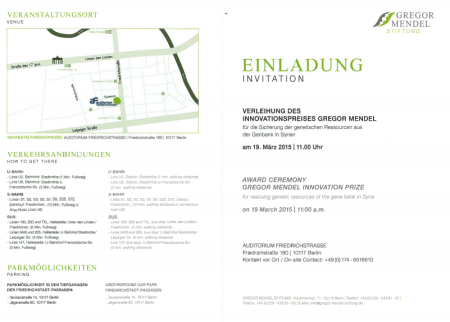More information on the ceremony for that award that the ICARDA genebank is to receive next month. It’s unclear to me from the invitation pamphlet to what extent the general public will be allowed in, but if you’re in Berlin on 19 March and would really like to go, my suggestion is to contact the Gregor Mendel Foundation and find out if they’ll let you register. You have until 4 March to do so. Looks like it’ll be quite a party.
Nibbles: History of beer, St Bridget, Gaulish bread, Ancient cocktails, PGR course, ECHO, Breakfast pix, Development vs biodiversity, Fairtrade African veggies, Indian medicinals, Phytoliths, CC adaptation
- I say ale, you say beer.
- Ireland has a patron saint of beer. Well of course it does.
- The bread of the Gauls was made from beer foam.
- Reviving ancient beers. Wait, what’s with all this beer today?
- Genetic Resources in Plant Breeding: Conservation, Characterization and Utilization, 17-28 August 2015, Swedish University of Agricultural Sciences (SLU), Alnarp, Sweden: More detailed information on this course coming soon…
- Not that these guys in Florida need it.
- Pix of kids’ breakfasts from around the world.
- Development and biodiversity can coexist: here come the data.
- African leafy veggies have truly arrived, haven’t they, if they’re getting the Fairtrade treatment.
- But it might be too late for some medicinal plants.
- Phytoliths 101.
- What’s that you say? You want to integrate agrobiodiversity in your climate adaptation plans? Got just the thing for you.
Brainfood: Amorphophallus diversity, Physiological phenotyping, Jatropha diversity, Ass origins, Prickly lettuce diversity, Sugarcane in vitro, Pennisetum diversity, ABS and Norway, Seed storage behaviour, Barley diversity, Lentil diversity, Bilberry characterization, Potato genomics, Asian horse ABS
- Cytotaxonomic investigations to assess diversity and evolution in Amorphophallus Blume ex Decne. (Araceae). Out of 25 accessions and 7 wild species, “A. dubius may be the immediate ancestor of cultivated forms.”
- Physiological phenotyping of plants for crop improvement. High-throughput phenotyping is only the start.
- Geographic origin is not supported by the genetic variability found in a large living collection of Jatropha curcas with accessions from three continents. 900 global accessions fall into 2 genetic groups, but not related to geography.
- Genetic diversity of donkey populations from the putative centers of domestication. Sudan and/or Yemen.
- Genetic and Biochemical Evaluation of Natural Rubber from Eastern Washington Prickly Lettuce (Lactuca serriola L.). I look forward to seeing those rubber lettuce plantations.
- An approach on the in vitro maintenance of sugarcane with views for conservation and monitoring of plant nuclear DNA contents via flow cytometry. It’s possible to conserve sugarcane in vitro, but it won’t be straightforward.
- Geographical Gaps and Diversity in Deenanath Grass (Pennisetum pedicellatum Trin.) Germplasm Conserved at the ICRISAT Genebank. 194 provinces in 21 countries? That’s a lot of gaps.
- Realizing access and benefit sharing from use of genetic resources between diverging international regimes: the scope for leadership. As supplied by Norway, that is.
- Classification of seed storage behaviour of 67 Amazonian tree species. 1000-seed weight and seed moisture content at shedding are good, together, at predicting seed storage behaviour.
- Genetic Diversity and Population Structure in a Legacy Collection of Spring Barley Landraces Adapted to a Wide Range of Climates. 10 climatic clusters.
- Assessment of genetic variation within a global collection of lentil (Lens culinaris Medik.) cultivars and landraces using SNP markers. Geographic pattern for commercial varieties, but not for landraces.
- Omne Ignotum pro Magnifico: characterization of commercial Bilberry extracts to fight adulteration. That would be Vaccinium myrtillus. You need to keep a sharp eye on the whole production process.
- The Contribution of the Solanaceae Coordinated Agricultural Project to Potato Breeding. It boils down to the Infinium 8303 Potato SNP Array, and it’s contribution to potato breeding has apparently been important.
- Horses as Sources of Proprietary Information: Commercialization, Conservation, and Compensation Pursuant to the Convention on Biological Diversity. You need a value chain with “a sequence of proprietary rights agreements governed and regulated by both tangible and intangible property regimes.” Well, yeah.
Genebanks galore on the BBC
Never rains but it pours, BBC edition. Hot on the heels of the Food Programme on the conservation of heritage wheats, here comes Gardeners’ Question Time on the cacao genebank at the University of Reading.
Wheat roundup
Great to get an email update from Andy Forbes yesterday on the latest developments at Brockwell Bake. They’ve been busy with their Nordic colleagues of late, as you can read in the latest edition of True Loaf. ((But what about in like-minded enthusiasts in the US?)) But the big news is they’ll be on the BBC’s Food Programme later today, along with lots of other heritage wheat enthusiasts.
And the wonderful Wheat Gateway has had a couple of tweaks over Christmas:
Wheat *hub *pages such as for Hen Gymro are intended to link up available historical references, morphological descriptions and modern imagery to germplasm data and in due course current cultivation and usage reports for landrace and other heritage lines of specific interest.
“*with image*” searches on the database has been added so the various image resources (USDA, INRA, BBA, NordGen) can be targeted by users – inspired to do so by the immaculate image collection of the Nordic Genebank.
Brockwell seem to be cornering the market in wheat genetic resources information systems.
Oh, and since we’re at it, here’s philosopher Julian Baggini on our duty of stewardship towards einkorn.

